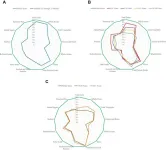(Press-News.org) Scientists from the German Cancer Research Center (DKFZ) and the University Medical Center Mannheim (UMM) successfully tested a new form of cellular immunotherapy against brain tumors in mice for the first time.
Glioblastomas are the most aggressive of all brain tumors. They spread diffusely in the brain and are difficult to remove completely by surgery. Chemotherapy or radiation therapy also often have limited effectiveness. To find new, more effective treatment options for those affected, doctors and scientists are testing numerous immunotherapeutic approaches, including so-called "adoptive" T-cell therapies: This involves isolationg T cells from the patient, modifying them in the culture dish and transferring them back to the patient. Doctors are pursuing a variety of approaches.
Lukas Bunse, a scientist at the German Cancer Research Center (Deutsches Krebsforschungszentrum, DKFZ) and a physician at the University Medical Center Mannheim, relies on the comparatively new concept of "T cell receptor transgenic cells" in his current study: To this end, brain tumor patients were first inoculated with an antigenic fragment of the protein NLGN4X (Neuroligin4X). This protein is involved in the formation of synapses. It is found in large quantities in glioblastoma cells, but is virtually undetectable in healthy brain tissue.
Bunse's team then isolated from the blood of the vaccinated individuals those T cells that had been activated by NLGN4X and consequently carried a T cell receptor that specifically "recognizes" this glioblastoma-associated antigen.
However, since only a few NLGN4X-specific T cells can be obtained in this way, which are not sufficient for cell therapy, the scientists resorted to a trick: they isolated the gene coding for the NLGN4X-specific T cell receptor. They were then able to use this to equip T cells from donor blood or also T cell lines in the culture dish. In this way, they succeeded in producing large numbers of T cells with identical specificity, all of which recognize the cancer antigen NLGN4X.
Bunse's team then demonstrated that the NLGN4X-specific T cells are able to kill brain tumor cells in the culture dish. Brain tumor-bearing mice treated with transgenic NLGN4X-specific human T cells had a greater than 40 percent response to treatment. The tumors shrank and the animals survived longer than untreated conspecifics.
After these initial studies had yielded such promising results, Lukas Bunse expects that vaccine-induced T-cell receptors targeting brain tumor antigens could be a promising approach to develop new immunotherapies against glioblastoma. In melanoma, the malignant black skin cancer, such T-cell receptor transgenic T cells have already been shown to prolong the lives of some patients. According to the scientist, it is also conceivable to generate T cell receptor transgenic cell therapies against patient-individual cancer antigens.
Much more advanced in clinical development than T-cell receptor transgenic cells are cellular therapies using so-called CAR-T (chimeric antigen receptor) cells, which have already been approved for the treatment of various leukemias and lymphomas. But the two cell therapy approaches differ in one important respect. "With the T-cell receptor transgenic cells, we can also target antigens that are only found inside cancer cells and whose fragments are exhibited on the cell surface via presentation molecules known as MHC class 1," explains Lukas Bunse. This is not possible with the receptor of the CAR-T cells.
Michael Platten, director of the Department of Neurology at the University Medical Center Mannheim and department head at the German Cancer Research Center, sums up, "We will now work intensively to be able to test this concept in the clinic."
C. Krämer, M. Kilian, YC. Chih, A. Kourtesakis, D. C. Hoffmann, T. Boschert, P. Koopmann, K. Sanghvi, A. De Roia, S. Jung, K. Jähne, B. Day, L. D. Shultz, M. Ratliff, R. Harbottle, E. W. Green, R. Will, W. Wick, M. Platten and L. Bunse: NLGN4X TCR transgenic T cells to treat gliomas. Neuro-Oncology 2023, https://doi.org/10.1093/neuonc/noad172
With more than 3,000 employees, the German Cancer Research Center (Deutsches Krebsforschungszentrum, DKFZ) is Germany’s largest biomedical research institute. DKFZ scientists identify cancer risk factors, investigate how cancer progresses and develop new cancer prevention strategies. They are also developing new methods to diagnose tumors more precisely and treat cancer patients more successfully. The DKFZ's Cancer Information Service (KID) provides patients, interested citizens and experts with individual answers to questions relating to cancer.
To transfer promising approaches from cancer research to the clinic and thus improve the prognosis of cancer patients, the DKFZ cooperates with excellent research institutions and university hospitals throughout Germany:
National Center for Tumor Diseases (NCT, 6 sites)
German Cancer Consortium (DKTK, 8 sites)
Hopp Children's Cancer Center (KiTZ) Heidelberg
Helmholtz Institute for Translational Oncology (HI-TRON Mainz) - A Helmholtz Institute of the DKFZ
DKFZ-Hector Cancer Institute at the University Medical Center Mannheim
National Cancer Prevention Center (jointly with German Cancer Aid)
The DKFZ is 90 percent financed by the Federal Ministry of Education and Research and 10 percent by the state of Baden-Württemberg. The DKFZ is a member of the Helmholtz Association of German Research Centers.
END
Transgenic T cells against malignant brain tumors
2023-09-26
ELSE PRESS RELEASES FROM THIS DATE:
Aston University research pioneers making renewable hydrogen and propane fuel gases from glycerol
2023-09-26
Research shows way forward for making renewable hydrogen from glycerol
Crude glycerol from biodiesel production plants cheap and abundant
Could benefit the environment and reduce reliance on fuel imports.
26 September 2022 | Birmingham, UK
Aston University research has shown the way forward for making renewable hydrogen and propane fuel gases from glycerol.
An organic compound, glycerol is produced mainly from fats and oils and is often used in health and beauty products.
With crude glycerol from biodiesel production plants cheap and abundant the researchers have ...
SRI spins off AI-powered drug discovery platform Synfini, Inc.
2023-09-26
SRI International announced today it is spinning off Synfini, a biosciences platform that accelerates the process by which pharmaceutical and other companies can design, synthesize, and bring to market molecules for drug development.
The technology brings together a suite of software and hardware solutions developed at SRI through a significant, multi-year development effort. The suite includes a neuro-symbolic AI molecule designer, a computational synthetic planning tool, a high-throughput automated chemistry system, and a flow chemistry hardware platform that reliably performs multi-step synthesis.
“At SRI we are always tremendously excited to ...
Research reveals why our skin feels ‘tight’
2023-09-26
When we wash our face with a cleanser, our skin can start to feel tight. With the application of a favorite moisturizer, that feeling often goes away. This perception of our skin might seem subjective, but researchers at Stanford recently revealed the mechanism behind these feelings.
Their work, published this week in PNAS Nexus, demonstrates how mechanical changes at the outer surface of our skin translate into sensations and provides a quantitative approach for determining how people will perceive their skin after using a moisturizer or cleanser.
“This work provides ...
World-class neutron source takes a break for major Proton Power Upgrade
2023-09-26
The Spallation Neutron Source at Oak Ridge National Laboratory — already the world’s most powerful accelerator-based neutron source — will be on a planned hiatus through June 2024 as crews work to upgrade the facility.
Much of the work — part of the facility’s Proton Power Upgrade project — will involve building a connector between the accelerator and the planned Second Target Station at SNS. When complete, the PPU project will bring the accelerator up to 2.8 megawatts from its current record-breaking ...
Study sheds new light on strange lava worlds
2023-09-26
COLUMBUS, Ohio – Lava worlds, massive exoplanets home to sparkling skies and roiling volcanic seas called magma oceans, are distinctly unlike the planets in our solar system.
To date, nearly 50% of all rocky exoplanets yet discovered have been found capable of maintaining magma on their surfaces, likely because these planets are so close to their host stars they orbit in fewer than 10 days. Being so close causes the planet to be bombarded by harsh weather and forces surface temperatures to the extreme, making it all but completely inhospitable to life as we know it today.
Now, in a new study, scientists have ...
Latest version of the Healthy Eating Index covers toddler diet quality
2023-09-26
Philadelphia, September 26, 2023 – In four articles in the Journal of Nutrition and Dietetics, published by Elsevier, leading nutrition experts describe and evaluate the latest versions of the Healthy Eating Index (HEI), issued to correspond to the 2020-2025 Dietary Guidelines for Americans (DGA). For the first time, there are two new HEIs, one for children and adults 2 years and older, and one for young children aged 12 through 23 months.
The Call to Action of the ninth edition of the Dietary Guidelines for Americans is “Make Every Bite Count.” These guidelines form the basis of nutrition policy ...
U of M Medical School research team studies homicides of health professionals
2023-09-26
MINNEAPOLIS/ST. PAUL (09/26/2023) — Published in the Journal of Clinical Psychology, University of Minnesota Medical School researchers examined homicide rates of health professionals in the United States to inform prevention interventions and strategies.
The research team used the Centers for Disease Control and Prevention’s National Violent Death Reporting System (NVDRS) to collect data on the number of homicides among ten types of health professionals, including doctors, psychologists, nurses, social workers and pharmacists.
The study found rates of homicides ...
UH researcher on team developing sense-and-respond cancer implant technology
2023-09-26
The Advanced Research Projects Agency for Health (ARPA-H) has awarded $45 million to rapidly develop sense-and-respond implant technology that could slash U.S. cancer-related deaths by more than 50%.
The award to a team of researchers from seven states, led by Rice University, will fast-track development and testing of a first-of-its-kind approach to cancer treatment that aims to dramatically improve immunotherapy outcomes for patients with ovarian, pancreatic and other difficult-to-treat cancers.
Weiyi Peng, assistant professor ...
U of M Medical School receives $16 million to uncover the 'wiring diagram' of the brain
2023-09-26
MINNEAPOLIS/ST. PAUL (09/26/2023) — The University of Minnesota Medical School received a $16 million grant from the National Institutes of Health (NIH) Brain Research Through Advancing Innovative Neurotechnologies® (BRAIN) Initiative to support the groundbreaking project of unraveling the mysteries of the brain's ‘wiring diagram.’ Using cutting-edge techniques, this research aims to discover how the brain's neurons are connected and communicate with each other.
The project aims to better understand how complex neural ...
Arctic sea ice 6th lowest on record; Antarctic sees record low growth
2023-09-26
Arctic sea ice likely reached its annual minimum extent on Sept. 19, 2023, making it the sixth-lowest year in the satellite record, according to researchers at NASA and the National Snow and Ice Data Center (NSIDC). Meanwhile, Antarctic sea ice reached its lowest maximum extent on record on Sept. 10 at a time when the ice cover should have been growing at a much faster pace during the darkest and coldest months.
Scientists track the seasonal and annual fluctuations because sea ice shapes Earth’s polar ecosystems and plays a significant role in global climate. Researchers at NSIDC ...





